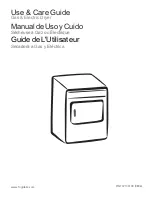
Operating Instructions, Tips
11
Clothes Dryers Owner’s Instructions
Operating Instructions, Tips
LOADING CLOTHES
• Preparing Laundry
Check that all fastenings are closed and that pockets are empty.
Place laundry loosely in the drum to make sure that they don’t get tangled.
• Sort laundry as follows (Examples)
As a general rule, sort clothes by surface texture, fabric, color and weight,
as you would for your washer.
By care symbols
Suitable for tumble drying
Tumble drying at low temperature only
Do not tumble dry
By amount and weight
Lightweight fabrics dry faster than heavyweight fabrics. If mixed loads are
dried together(such as sheets and towels), remove the lighter weight fabrics to
prevent over drying and wrinkling.
Whenever the load is bigger than the dryer capacity, separate laundry accord-
ing to weight.(ex, towels from thin underwear)
By type of fabrics
Cotton/Linen : Made of cotton or linen
Synthetics : Made of polyester or polyamide as well as for cotton/synthetic
mixes.
Delicates : Sensitive fabrics
By drying level
Extra dry, cupboard dry, iron dry, etc.
•
Do not tumble dry the following items :
woolens, silk, delicate fabrics, nylon stocking, delicate embroidery, fiberglass
items, rubber-coated items, plastics, items with plastic trim, foam-filled items,
items with metallic decorations and bulky items such as sleeping bags, etc
- Clothing with metallic components may damage the drum interior during
drying.
•
Do not overload.
Excessive loads don’t dry efficiently and cause wrinkling.
•
Do not add fabric softener sheets once the load has become
warm.
Polyester Knits & Permanent Press Drying Tips
•
DO NOT OVERLOAD
- Garments being dried or de-wrinkled should tumble
freely.
•
REMOVE CLOTHES PROMPTLY
- To help prevent wrinkling, remove
clothes from the dryer promptly at the end of the drying cycles.
•
PLACE ON HANGERS
- Permanent press and polyester knit garments look
best if placed on hangers after drying.
Programs
Laundry Type
Example for
Synthetics
Heavy weight or multi-layered fabrics
Track suits, Towelling materials,
bath robes
Normal cotton and linen articles
Sheets, and pillowcase, table-
cloths, cotton trousers
Drying Times
It is impossible to give exact drying times. Conditions from home to home vary and
directly affect drying times. The length of time it takes to dry loads will depend on
several things.
•
Load Size
•
Type of fabric, washer, and spin speed will determine moisture in the fabric.
•
Heat and moisture in the room. Damp air coming into the dryer will increase drying
time.
•
Installation (Length of exhaust duct, etc)
•
Electric voltage.
If you select an automatic cycle, the machine will determine the time needed for drying.
During the DRY Cycle, the remaining time may be increased or decreased in order to
optimize dryness.
Cottons
Extra
Cupboard
Cotton and linen articles to be
ironed.
Tablecloths and shirts
Cotton underwear
Iron
Heavyweight or multi-layered fabrics
Sweatshirts, bed linen and table
linen
Extra
Normal synthetic fabrics
Delicate dresses, skirts, shirts
Cupboard
Very delicate fabrics
Easy care fabric and blouses
Delicate underwear
Iron
For leaving items partially damp
Cupboard
Delicates
10
Clothes Dryers Owner’s Instructions
PROGRAM SELECTING GUIDE



























